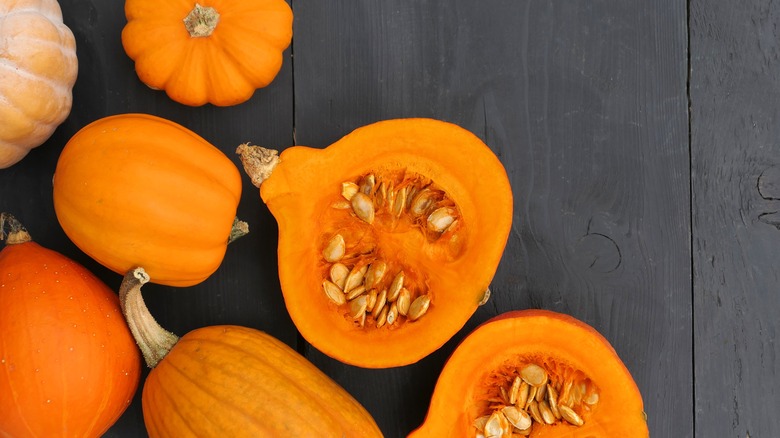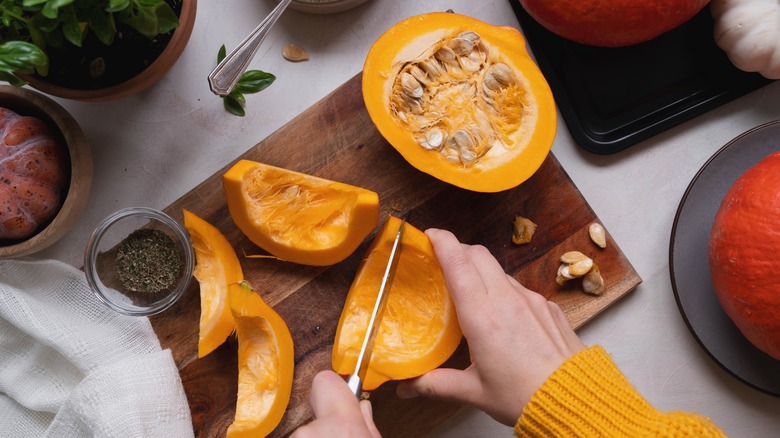Can Adding Pumpkin To Your Diet Help Lower Your Blood Sugar Levels?
Pumpkins are a fall favorite, especially for many people in America. While the infamous PSL (aka pumpkin spice latte), pumpkin pie, pumpkin bread, and other pumpkin baked goodies make their debut this holiday season, it's tough to imagine how healthy pumpkin can actually be. But rest assured, this winter squash is extremely healthy, points out Healthline. Legend has it that pumpkins are so healthy that a poor Chinese girl's parents who were deathly ill were miraculously cured shortly after consuming them (per Legacy of Taste). But how?
First off, pumpkins are extremely nutrient dense and low in calories. One cup (or 245 grams) of canned pumpkin clocks in at 137 calories, explains the U.S. Department of Agriculture (USDA). It contains roughly 2.65 grams of protein, 19 grams of carbohydrates, 7 grams of fat, and 7 grams of dietary fiber. It's also loaded with vitamin C, vitamin E, potassium, calcium, and magnesium. Alternatively, if you're looking at snacking on pumpkin seeds with the shell, a 1-ounce serving has 86 calories, according to the USDA. The seeds contain 4 grams of protein, 7 grams of fat, 1 gram of fiber, and 2 grams of carbohydrates.
Given the nutritional profile of pumpkins, there may be some truth hidden in this Chinese legend. Healthline explains that adding pumpkin to your diet can support skin, eye, and heart health. But are the nutrients found in pumpkins strong enough to help lower your blood sugar levels too?
How pumpkin affects blood sugar levels
In order to answer the question, it's important to take a look at the concepts of glycemic index (GI) and glycemic load (GL). According to Harvard Health Publishing, the glycemic index is a scale between 0 to 100 that ranks a food based on how fast it causes your blood sugar levels to rise. Foods ranked low on the list raise the blood sugar levels slowly, whereas foods higher on the index raise levels higher and more quickly, explains Mayo Clinic. Pumpkins tend to fall on the higher side of the GI and have a value of 75, shares Healthline.
Glycemic load, on the other hand, is also a ranking system. But instead, this system classifies how quickly food (in this case pumpkin) will actually raise your blood sugar as well as the amount of glucose it packs per serving, points out Harvard Health Publishing. On this scale, pumpkins tend to be on the lower side and have a GL score of 3 (per Healthline). With that in mind, it's important to eat pumpkin in a single serving if you're concerned about its glycemic index.
Pumpkins support metabolic health
That's not to say pumpkins should be avoided, as pumpkins support metabolic health, which helps to manage blood sugar, points out Healthline. This is because pumpkins are loaded with beta carotene, which gives it its orangish color. The British Journal of Nutrition reports that diets high in carotenoids can improve metabolic health.
Animal studies have also shown how powerful pumpkins can be in reducing blood sugar levels, explains Healthline. One 2022 study conducted on diabetic rats examined how effective different forms of pumpkin (i.e. pumpkin flesh, peel, or seed powder) can be at reducing blood sugar levels in 28 days. What the researchers found is that pumpkin seed powders had the most significant impact on blood glucose level, followed by pumpkin peel powder. Pumpkin flesh powder lowered blood glucose levels, but was less significant when compared to the others. A different animal study published in Preventive Nutrition and Food Science reported that pumpkin seed protein can positively affect metabolic parameters such as improving blood pressure, glucose, and insulin levels. It also protects the cells from oxidative stress that's caused by a diet high in fructose.
So, can adding pumpkin to your diet lower your blood sugar levels? It's possible, but more human research is needed to confirm these benefits, says Healthline. In the meantime, they recommend focusing on your overall diet rather than the sporadic pumpkin treat.



